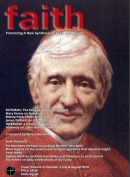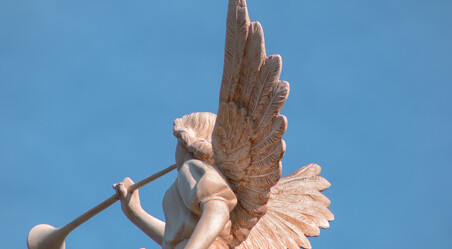Cutting Edge - A Monthly Review Of Scientific News
FAITH Magazine March-April 2004
The Beatified Scientist
An important part of combating the myth of the opposition of faith and science is a proper historical appreciation of the irreplaceable contribution of men of faith to the rise of science and its great leaps: scientists who rigorously studied the natural world precisely because it is God’s own order given to the world that makes it rational and worthy of investigation.
It is fifteen years since October 1988 when the Pope raised the only scientist as yet to the rank of a beatus, and two books have just appeared on the scene almost simultaneously to make better known the story of this incredible man, scientist and believer. Neils Stensen, popularly known as ‘Steno,’ was a seventeenth-century Danish Lutheran who died a Catholic bishop in north-east Germany, aged only forty-eight. In that short life, however, he managed to turn the science of his day on its head. On his monument in Copenhagen where Steno was born in 1638 are written the words Anatomicus, Geologiae Fundator, Servus Dei, which certainly sum up the achievements of this prodigious experimental scientist: “Anatomist, Founder of Geology, Servant of God.” Abandoning besieged Copenhagen at the endof 1659, he went first to Amsterdam and then to Leiden, pursuing a training in medicine, so that by the time he arrived in Paris in 1665 his skills as an anatomist were very evident. He amazed the medical establishment in Paris by his demonstrations of dissection with a dexterity second to none, by his discoveries of various glands, and by his findings regarding the functioning of muscles and the brain. Accepted opinions in medicine from the likes even of Descartes were being regularly overturned by the young Dane. Within a year, however, he had moved to Florence, where the grand duke was a great patron of the sciences and sponsored an experimental academy. Steno was quickly admitted to this academy and it was here that his career took its first sharp turn. Charged by the grand duke withdissecting for the court the head of a recently captured great white shark, Steno realised the evident truth of what a few others had already postulated, namely that the ‘tongue stones’ found in plenty in places like Malta were indeed identical with sharks’ own teeth. This set up Steno’s conversion to pursue new interests in the then-nonexistent discipline of geology, with a special concern for answering the burning question of how stone fossils resembling living creatures came to exist within rocks. Expressed glibly, how was it that fossil seashells were often to be found on mountaintops, far from any sea?
Even in his 1667 dissertation on the shark’s head, Steno had already shifted from anatomy to geology, and laid down the basics of his new hypothesis, that many rocks must be formed from the settling of sediments in layers from suspension in a fluid. The next two years saw him work tirelessly on this subject, investigating in the field the richly varied geology of the Tuscan landscape, such that by 1669 he had published his most thorough and ground-breaking work, a “provisional report,” as he called it, De Solido, “on solid bodies which are found naturally embedded in other solid bodies.” In a dense seventy-six pages of Latin he more-or-less founds the whole science of geology, the treatise covering sedimentation and crystallography, and of course, while without mentioning precise dates,clearly demonstrating that the age of the earth was vastly in excess of the hitherto reckoned age of some five or six thousand years.
At this same time, however, at the very height of his scientific powers, his life took another dramatic turn, and leaving the Protestant Lutheran beliefs of his childhood upbringing he embraced the Catholic faith which he had discovered in Italy. It was this discovery more than any of his impressive scientific achievements which was to mark his remaining life’s work. Having converted to Catholicism in 1667, when he then returned to Lutheran Denmark in 1672 to take up a post as the royal anatomist he found the religious attitudes somewhat oppressive, and he encountered the pressing needs of the minority Catholic popluation in northern Europe. On a subsequent return to Florence, then, he trained for holy orders and was ordained a priest on Easter Eve 1675. The rest of his life he devoted tothe Church, especially in Northern Germany, Denmark and Norway, whose Catholics were placed under his care when he was made a bishop in 1677. He embraced an extreme asceticism, and became famous for the conversions he fostered, even in the lonely and austere climate of Protestant northern Europe, and for his care of the poor. And in the midst of this pastoral work he died, at Schwerin in northern Germany, in 1686.
Hans Kermit writes: “For Stensen there was no conflict between faith and knowledge. For him they were but two sides of the same thing. The role of science was to provide insight into the beauty of the Creator’s work and to generate love for him.” Steno’s own famous saying sums up his attitude to the interconnecting world of science and faith: “That which we see is beautiful; that which we understand is even more beautiful; but the most beautiful of all is that which we cannot grasp.”
The Seashell on the Mountaintop: a Story of Science, Sainthood, and the Humble Genius who discovered a New History of the Earth by Alan Cutler (228 pp., ISBN 0-434-00857-5) is published by Heinemann. Neils Stensen: the Scientist who was Beatified by Hans Kermit (179pp., ISBN 0-85244-583-0) is published by Gracewing.






